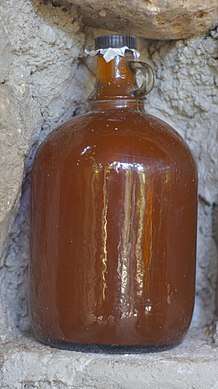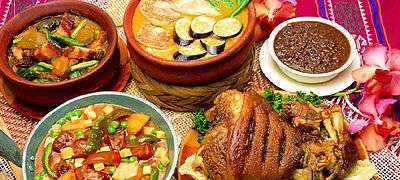Tubâ
Tubâ (Tagalog pronunciation: [tʊˈbaʔ]) is a Filipino alcoholic beverage created from the sap of various species of palm trees.[1] During the Spanish colonial period, tubâ was introduced to Guam, the Marianas, and Mexico via the Manila Galleons. They remain popular in Mexico, especially in the states of Colima, Jalisco, Michoacán, and Guerrero. Tubâ was also introduced to the Torres Strait Islands of Australia in the mid-19th century by Filipino immigrant workers in the pearling industry.[2][3][4]
_-_cropped.png) | |
| Type | Palm wine |
|---|---|
| Country of origin | Philippines |
| Alcohol by volume | 2%-4%[1] |
History
Tubâ has existed in the Philippines since pre-colonial times. They were widely consumed for recreation as well as play an important role in the animist religious rituals presided by babaylan shamans. Heavy consumption of tubâ and other alcoholic beverages in the Philippines were reported by early Spanish colonizers. Social drinking (tagayan or inuman in Tagalog and Visayan languages) was and continues to be an important aspect of Filipino social interactions.[5][6][7]
A peculiar and universal drinking custom of the islands is the sharing of a single drinking container. During tagayan, one person (usually the owner of the beverage) becomes the tangero who fills a cup with a serving of alcohol (a tagay). A person in the group then drinks the cup and passes it back to the tangero for a refill. The tangero fills the cup again and passes it to the next person, and so on. Another practice is to drink from the same container at the same time using drinking straws made from hollow reeds or bamboo. Tagayan was usually accompanied by a shared serving of food known as pulutan. The ritual and terminology of tagayan was recorded in the Bocabulario Tagalog manuscript (1630) by Fray Miguel Ruiz, and they remain largely unchanged today. Tagayan is also related to the ancient Filipino practice of sandugo (blood compact), as both reinforce camaraderie and social bonds among participants by drinking from the same vessel.[6][7][8]
During the Spanish colonial period, distillation technologies were adopted by native Filipinos as early as 1574, resulting in improvised stills known as kawa. These were used to distill tubâ into a palm liquor known as vino de coco or vino de nipa, which is now known as lambanóg in modern times.[5]
Regional variations
Bahal
Bahal is a type of tubâ that is distinctively orange to brown in color because it has added extracts (barok) from the dried bark (marka tungog or tangal) of certain mangrove species (Ceriops tagal, Rhizophora mucronata, or Vateria indica). It is fermented for around a day to a few weeks. It is an intermediate stage in the production of bahalina wines. It originates from the Visayan regions of Visayas and Mindanao.[9][10]
Kinutil
Kinutil is tubâ mixed with raw egg yolks, tabliya chocolate, milk, and other ingredients. It is widespread in the Visayan regions of Visayas and Mindanao and is also known as kinutir, kutir, or dubado, among other names.[11][12][13]
Tuhak
Tuhak is a type of tubâ made from the sap of kaong palm (Arenga pinnata), locally known as kaong or cabonegro. It originates from the Caraga region of Mindanao. It is collected and fermented in the same way as tubâ. However, extracts from the bark of a tree known as lamud may sometimes be added to aid in fermentation and to prevent the souring of the sap. It is also known as hidikup or hidiup in Agusan del Norte and san in Agusan del Sur.[1][8]
Tunggang
%2C_Mindanao%2C_Philippines_03.jpg)
Tunggang is a type of tubâ made by the Manobo, Mandaya, and Mamanwa people from fishtail palm (Caryota spp.) sap. It is not as popular as other varieties of tubâ because it has a relatively more unpleasant smell and taste.[8]
Outside of the Philippines
Guam & the Mariana Islands
Tubâ production and coconut sap harvesting were introduced to Guam and the Mariana Islands (then part of the Spanish East Indies) by Filipino settlers. Their initial introduction is usually attributed to the Filipino assistants of the Spanish missionary Diego Luis de San Vitores in 1668. Tubâ quickly became a fixture of the culture in the islands, which previously had no native alcoholic drink. The Chamorro people developed two derivatives from tubâ: aguajente (also aguayente or agi, from Spanish aguardiente), a distilled liquor similar to Filipino lambanóg; and almibad, a sweet syrup made from boiled coconut sap used in making candies and rice cakes (potu). Tubâ itself was either consumed fresh (non-alcoholic) or fermented; with the former popular to women and children, and the latter popular to men.[14][15][16]
Soon after the acquisition of Guam by the United States from Spain in 1899, aguajente was banned by the American government. Anyone caught making it would get a prison sentence and a fine. The ban remained in place for the next 40 years, restricting tubâ only to the non-alcoholic and mildly alcoholic versions. In 1939, shortly before the outbreak of World War II, taxes were also levied on tubâ-producing coconut palms, further crippling the industry. Today, tubâ is rare in the islands and its production is in decline.[16]
Mexico
Tubâ, along with coconuts, were introduced to Mexico in the 16th to 17th centuries via the Manila Galleons to Acapulco through the Spanish-Asian trade route called the NAO of China. They remain popular in Western Mexico where they are known as tuba, particularly in the states of Colima, Jalisco, Michoacán, and Guerrero.[2][3][4] Mexican tuba is made in the same way as Filipino tubâ. The traditional sap collectors are known as tuberos (which also means "plumber" in both Mexico and the Philippines). It became so popular that in 1619, Captain Sebastian de Piñeda wrote to King Philip III of Spain complaining of the Filipino "Indio" settlers in Nueva España who were causing significant loss of profits to Iberian alcohol exporters due to tuba.[5][17]
Mexican tuba is also commonly sold as tuba fresca, a non-alcoholic version made from fresh coconut sap. Tuba fresca is traditionally sold by street vendors in large bottle gourds mixed with coconut milk, ice, and sugar. It is usually topped with walnuts and diced fruit.[18][19]
Torres Strait Islands
In the mid-19th century Filipino immigrant workers settled in the Torres Strait Islands in Australia to work in the pearling industry as divers and overseers. They settled in sizable communities in Horn Island, Thursday Island, and Hammond Island, numbering at around 500 by 1884. Despite Australian anti-miscegenation laws and the general racism of the Australian government at the time, many Filipinos intermarried with the native Torres Strait Islanders. They also transmitted various Filipino traditions and material culture to the natives, including stories, songs, recipes, various crop plants, and new technologies.[20][21][22]
One of these technologies were the methods for producing tubâ. The Islanders, who previously had no tradition of alcohol production or consumption, quickly adopted the tubâ and all its various uses. They consumed coconut sap fresh as a non-alcoholic beverage or as a dip for mangoes; they fermented it into tubâ proper which they also called tuba; they used it as yeast to make bread rise; and they distilled it into liquor which they referred to as "steamed tuba." Even though Australian government prohibitions existed from 1837 to the 1960s banning the sale and consumption of alcohol to Indigenous Australians, it failed to stop the popularity of tuba.[20][21]
After the introduction of even more restrictive race-based laws in 1901 and the collapse of the pearl and shell market, most Filipinos started leaving Australia and returning to the Philippines. By 1912, almost all of the Filipino population was gone, along with the pearling industry, leaving only the families who intermarried with the locals and their descendants. The tradition of tuba production, however, remained. During World War II, tuba was sold by the Islanders to American servicemen stationed in the Strait who were also familiar with tuba. Tuba is still an important part of Torres Strait Islander culture today.[20][21][22]
See also
| Wikimedia Commons has media related to Tubâ. |
References
- Sanchez, Priscilla C. (2008). Philippine Fermented Foods: Principles and Technology. UP Press. pp. 151–153. ISBN 9789715425544.
- Astudillo-Melgar, Fernando; Ochoa-Leyva, Adrián; Utrilla, José; Huerta-Beristain, Gerardo (22 March 2019). "Bacterial Diversity and Population Dynamics During the Fermentation of Palm Wine From Guerrero Mexico". Frontiers in Microbiology. 10: 531. doi:10.3389/fmicb.2019.00531. PMC 6440455. PMID 30967846.
- Veneracion, Jaime (2008). "The Philippine-Mexico Connection". In Poddar, Prem; Patke, Rajeev S.; Jensen, Lars (eds.). Historical Companion to Postcolonial Literatures - Continental Europe and its Empires. Edinburgh University Press. p. 574. ISBN 9780748630271.
- Mercene, Floro L. (2007). Manila Men in the New World: Filipino Migration to Mexico and the Americas from the Sixteenth Century. UP Press. p. 125. ISBN 9789715425292.
- Gibbs, H.D.; Holmes, W.C. (1912). "The Alcohol Industry of the Philippine Islands Part II: Distilled Liquors; their Consumption and Manufacture". The Philippine Journal of Science: Section A. 7: 19–46.
- Lasco, Gideon. "Tagay: Why there's no Tagalog word for "cheers" and other notes on Filipino drinking culture". Health, Culture, and Society in the Philippines. Retrieved 6 May 2019.
- Garcia, Lawrence. "Tagay: A Look at Philippine Drinking Culture". Humaling. Retrieved 6 May 2019.
- Garvan, John M. (1912). "Report on the drinks and drinking among the Mandaya, Manobo, and Mangguangan Tribes". The Philippine Journal of Science: Section A. 7: 106–114.
- Polistico, Edgie. "Tungog". Philippine Food Illustrated. Retrieved 21 April 2019.
- "How Tuba and Bahalina, Also Known as Coconut Wine, Are Made". Delishably. Retrieved 21 April 2019.
- "Do You Know What Kinutil Is?". Bite Sized. Retrieved 5 May 2019.
- Damo, Ida. "Kinutil: The Filipino Mudslide Drink". ChoosePhilippines. Retrieved 5 May 2019.
- "Comfort food ng mga Waray". Kapuso Mo, Jessica Soho. GMA Public Affairs. Retrieved 5 May 2019.
- "Tuba: Guam's 'Water of Life' lives on". Stars and Stripes Guam. Retrieved 6 May 2019.
- "Filipinos on Guam: Cultural contributions". Guampedia. Retrieved 6 May 2019.
- "Tuba taxed, outlawed, now threatened by rhino beetle". Pacific Daily News. Retrieved 6 May 2019.
- "Culture of Colima". Explorando Mexico. Retrieved 5 May 2019.
- Esparza, Bill. "Beyond Aguas Frescas: Two Refreshing Mexican Coolers to Try This Summer". Los Angeles Magazine. Retrieved 5 May 2019.
- "Talking Tuba". Vallarta Today. Retrieved 5 May 2019.
- Brady, Maggie; McGrath, Vic (6 December 2010). "Making Tuba in the Torres Strait Islands: The Cultural Diffusion and Geographic Mobility of an Alcoholic Drink". The Journal of Pacific History. 45 (3): 315–330. doi:10.1080/00223344.2010.530811. PMID 21280393.
- Brady, Maggie; Book 3: Strong spirits from Southeast Asia (2008). First Taste: How Indigenous Australians Learnt About Grog. ACT: Alcohol Education and Rehabilitation Foundation. pp. 19–23. ISBN 9780980379129.
- Shnukal, Anna (2011). "A double exile: Filipino settlers in the outer Torres Strait islands, 1870s–1940s". Aboriginal History. 35: 161–178. JSTOR 24046932.
.png)

